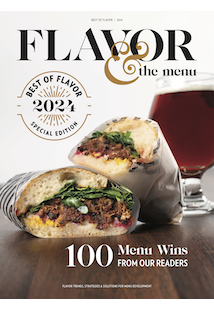
Chefs know the importance of a solid flavor punch, a unique twist on a familiar dish, and the power of delivering a flavor experience that is singular and memorable. Many of today’s flavor trends help them reach all three of those goals. Of course, there’s also great value in leveraging the less familiar—ingredients and techniques that intrigue guests and spark their curiosity. We’re highlighting four restaurant concepts that made us sit up and take notice, thanks to their unique flavor play. One experiments with fermented jalapeño and chickpea-miso butter in a pasta dish. The second uses sansho pepper in a dessert. The third combines tamarind and grapes in a sauce for barbecue chicken, and the fourth updates chicken and waffles with a savory take on the waffle.
Fermentation Showcase

Pizza Lupo’s Fermented Jalapeño Farfalle stands out with chickpea-miso compound butter, country ham and fresh corn.
Fermented items like kombucha and miso have entered the limelight in recent years, but fermented pasta? Less familiar. Max Balliet, Chef/Co-Owner of Pizza Lupo, is known for his passion projects, including experimenting with fermentation. His Fermented Jalapeño Farfalle stars egg pasta dough that takes out some of the egg white and replaces it with a purée of lacto-fermented jalapeño. “When you flavor pasta, you have to use something densely packed with flavor—the more intense the better,” he says. He then tosses the farfalle in a mixture of pasta water and housemade chickpea-miso compound butter and adds Benton’s country ham and fresh corn.
“Knowing that I wanted a spicy, sour, funky pasta flavor, I wanted to balance that with something sweet and rich,” says Balliet. “I decided to make the dish a fermentation showcase and use our chickpea miso. Chickpeas, or ceci, are the quintessential Italian legume, and they work great for miso.” He inoculates rice with koji (fungus) spores, and then blends the spores and the rice itself with chickpeas and a healthy dose of salt. This sits for a minimum of 6 months. “The koji breaks down the starches in the chickpeas into amino acids that give an incredible umami punch, and converts starches into sugars, which makes the whole ingredient salty, sweet and unctuous,” he says.
Sweet-Tart Finish

Restaurant Associates menus a Grilled Barbecue Chicken with red grape-tamarind sauce and roasted red grapes.
The sauce combination of tamarind with red grapes is unexpected and delicious. In an inspired move, Billy Strynkowski, Director of Wellness for Restaurant Associates, a subsidiary of Compass Group, pairs it with grilled barbecue chicken and a side of roasted red grapes.
“Pairing tart tamarind with sweet grapes, and then accenting these base ingredients with honey, cumin, and coriander, creates a striking, layered flavor profile that takes notoriously neutral chicken to the next level,” he says. “The grapes perfectly complement but do not smother the tartness of the tamarind. The result is an appealing burst of flavor. Pairing the finished chicken with a side of roasted grapes allows for more juicy grape flavor in a striking side.”
The grilled chicken is coated with the red grape-tamarind sauce, which caramelizes in the final cooking. He finishes the chicken with another brush of the sauce for added moisture. “The use of red California grapes and tamarind together creates this unique barbecue sauce with a delightful sweet-tart flavor that imparts the chicken with almost a Caribbean/Floridian vibe,” says Strynkowski.
A Surprising Finish

The Inn Ann menus a refreshing Sansho Spice Sorbet with sansho pepper, lemon and orange.
Through exhibitions and events, Japan House educates visitors about Japanese culture at its centers in New York, London, São Paulo and Los Angeles. The Inn Ann restaurant is a natural extension of the organization’s mission, where Executive Chef Mori Onodera introduces diners to authentic Japanese flavors. When developing the fine-dining concept’s tasting menu, he wanted to create a uniquely Japanese ice cream, turning to the unfamiliar sansho pepper to make the Sansho Spice Sorbet a signature dessert.
Sansho wasn’t Onodera’s first choice to flavor a frozen treat. He experimented with wasabi, but found its strong flavor overpowering. So he turned to the sansho pepper, relatively unknown in the United States, because he wanted to introduce American palates to it—and because he had a surplus in his pantry. The discovery proved serendipitous. These green pods boast citrus flavor and make the tongue tingle—fitting traits for a modern dessert.
Onodera layers sorbet with the sansho, lemon and other citrus, depending on seasonality (iterations have included yuzu and blood orange). “When enjoying the dish, the first impression is a light, refreshing citrus quality, then the numbing sensation from the sansho pepper kicks in for a satisfying finish,” he says.
Not-So-Southern Comfort

Horsefeather reimagines this classic in its Fried Chicken with a Serrano-pecorino waffle, miso butter, Brussels sprouts, bagna càuda and Sriracha honey
You can’t get more Southern than chicken and waffles. At Horsefeather, Executive Chef Ryan Chinchilla uses that classic comfort food to showcase the modern American style for which his restaurant is known. His Fried Chicken is served with a Serrano-pecorino waffle, miso butter, Brussels sprouts, bagna càuda and Sriracha honey.
“The Fried Chicken is a good example of the variety of influences used at Horsefeather,” he says. “The Brussels sprouts are sautéed in bagna càuda, which is herbaceous with garlic and anchovy oil. The sweet and spicy Sriracha honey ties the dish together, adding another layer of flavor, and the miso and waffle combine to make a really cheesy flavor.”
The dish is a top seller at Horsefeather. “Everyone loves fried chicken,” he says. “It’s a slam dunk on any menu. What makes ours stand out is the quality, attention to detail, and unique flavor profile while remaining approachable.”







